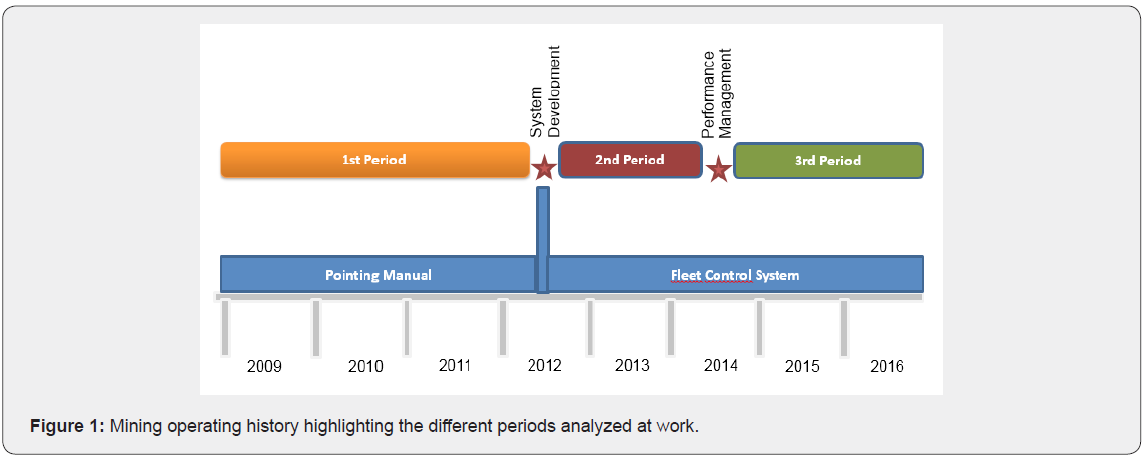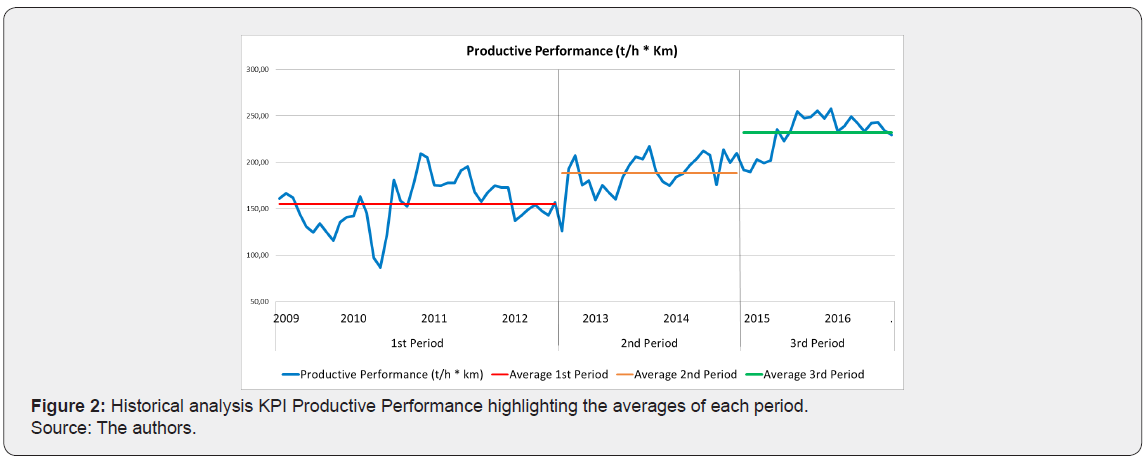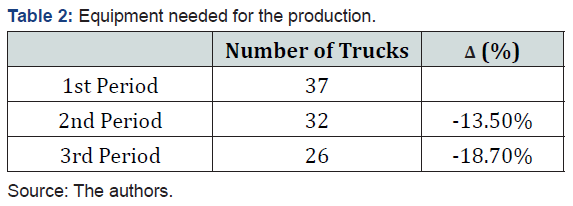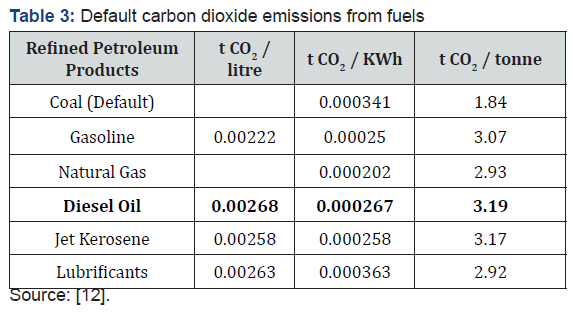Environmental and Operational Benefits through Implementing a Fleet Management System in Mining Industry
Walter Schmidt Felsch Junior1*, Carlos Enrique Arroyo Ortiz2, Adilson Curi2, Douglas Ramos Gonçalves3 and Alexandro Afonso Pinto4
1 Mining Engineer, PhD Student at the Universidade Federal de Ouro Preto, Brazil
2 Mining Engineer, Professor at the Universidade Federal de Ouro Preto, Brazil
3 Mining Engineer, Universidade Federal de Ouro Preto, Brazil
4 Mining Engineer, Mine Planning Manager at VALE, Brazil
Submission: April 24, 2020; Published: May 08, 2020
*Corresponding author: Walter Schmidt Felsch Junior, Mining Engineer, PhD Student at the Universidade Federal de Ouro Preto, Brazil
How to cite this article: Felsch Jr. W S, Arroyo C E O, Curi A, Gonçalves D R, Pinto A A. Environmental and Operational Benefits through Implementing a Fleet Management System in Mining Industry. Int J Environ Sci Nat Res. 2020; 24(3): 556140. DOI: 10.19080/IJESNR.2020.24.556140
Abstract
Mining fleet management is fundamental to the transportation infrastructure in a mining nowadays. Several factors influence the success of a new system adoption, such as changes in the project design, operational maturity, direct leadership engagement, and senior management participation. To start with, the main objective of this study is to present the results obtained with the implementation of the Fleet Management System in a mining company located in the Southeast region of Brazil. In this study, the chronology of the implementation of the technology was presented, comparing the operational factors and environmental impacts to the operation results. As a result, there was a 23% increase in the transportation fleet performance, which led to a monthly potential reduction in the emission of 136 tons of greenhouse gases in the atmosphere because of the reduction of the transportation fleet required for ore movement. Furthermore, these gains may be enhanced over the years, expanding its possibilities with the use of new techniques and research.
Keywords: Fleet management system; Performance analysis; Productivity increase; Mining equipment; GHG emissions
Introduction
A mine is similar to a manufacturing facility where raw materials are acquired and processed to a finished product that is shipped to customers. In the mining production cycle this process begins with the drilling, sampling and blasting of the raw material. After that, haul trucks that transport blasted material from a loading location to stockpiles or the crusher are closely tracked by a fleet management system. For instance, the demand for increasing competitiveness, associated to the adoption of new knowledge and technologies is present in every company and organizations of all segments. In the specific case of mining, productivity gains and cost reduction need specific solutions, usually developed for harsh conditioned environments that are not found in another kind of business. Moreover, applications in the world involving the use of GPS technology in fleet control has existed in mining since the decade of 1970, but each implementation shows its adaptation challenges to operating conditions.
Firstly, mining companies are conditioned to constantly reinvent themselves to survive, as they must always strive to be more efficient and sustainable [1,2]. Also, automation has played a key role in the production process and has improved operational performance in mining companies by increasing the presence of technology in the work routine of technical teams. Thus, the aim of this paper is to present a case study on the implementation of a fleet management system, also known as an electronic order in a mine, located in the Southeast region of Brazil, it analyzed data from operational KPIs obtained from the use of an automated fleet allocation compared to a manual control production. Before that, a survey of historical data for the period prior to the implementation of the fleet control system was made to compare it to the information generated in the post-implementation period. Manual control for production systems portrays a practice of truck dispatching in which a technician responsible for the equipment direction control is located in a strategic mine point and makes decisions based on the situation analyzed on his field of vision. Also, it is based on his experience, and by sending instructions to the operators of load and transport equipment.
Secondly, drivers use pen and paper for taking notes of the trips (loading and transportation), and this information is then stored in manual control spreadsheets. Therefore, manual information has a great potential for errors at various stages of the process which leads to a low data reliability. In the case of mining, recording mass moved and operational stops made by the equipment operators by using paper and pen may contain incorrect information. Also, a later typing of the information in a spreadsheet might contain errors and be manipulated. Other important operational processes are related to the low assimilation to the manual system, such as driving the equipment for supply, meals, and shift changes, among others. Also, various methods have been developed to implement transport equipment allocations, and these methods can be grouped into three basic types of fleet management systems: Manual systems; Semi-automatic Systems (static allocations); and Automatic Systems (dynamic allocations) [3].
After the implementation of the fleet control system, the same KPIs were analyzed using the information contained in the database that integrates the system to compare the information which was manually raised at the beginning of the program operation. By the moment this data was processed, it was noticed a significant gain in the productive performance of the equipment in the first few months after the system deployment. Consequently, these gains have risen gradually over the years showing the assimilation of the software within the production process.
For instance, automated dispatch systems were introduced in the market at the end of the ‘70s. By definition, these systems have the ability to directly allocate the truck to a task, overcoming limitations imposed by manual operation. One example of this limitation is when dealing with a large volume of information in a short time because it is difficult to analyze the current situation and take effective allocation decisions [4]. In recent years, researchers have investigated a variety of approaches to improving mine equipment performance using embedded technologies to reduce diesel consumption greenhouse gases emissions into the atmosphere [5-7].
As a matter of fact, the main benefits provided by the fleet management systems are: the automatic control of the mass moved according to the origin of the loading and its tipping location; Identification of the main reasons for fleet stoppage, generating the opportunity to reduce and eliminate manageable operational occurrences; Implementation of quality control of the ore, with the insertion of the planned mass for each mining front, inserted by the mine planning area; Control of operational performance of operational teams, equipment operators and working day periods.
A well planned and implemented fleet control system can generate good savings for the mining companies. That is why there is efficiency for having a computerized order maximizing the time at the mine, minimizing the number of trucks needed for transport, increasing the production of load equipment by reducing idleness and meeting the quality standards of the plant process [8]. An inadequate decision may compromise the quality of the ore produced, or decrease the productivity of the various equipment, incurring productivity loss [9].
Materials and Method
This study uses current data production notes that were taken manually by the operators and data generated through the database of the fleet management system of loading and transport equipment of this mine under study.
In the project, the following assumptions were taken:
a) Provide the mine operation, planning, accounting and maintenance departments with tools for analysis of comprehensible and reliable information.
b) Provide high-level supervision staff with tools for quality inspection.
c) Eliminate duplication of work connected to updating maps, plans and diagrams in paper and electronic forms.
Also, the methodology and data analysis will be presented, comparing the pointing manual information to the fleet management system information.
Pointing manual
The trucks are directed to be loaded by a manual way, using the communication radio. The fleet controller cannot track the location of the equipment to seek a better allocation, and it can generate several losses in the mining production process, mainly due to the lack of management associated to the control of the equipment.
Employees who operate the equipment use pen and paper to write down equipment activities and their shutdowns. Moreover, the cycles are informed, containing the loading and dump ones as well as the number of trips made. Thus, if any downtime is required, these should also be noted for its reasons. Finally, these notes, called the “daily part”, are sent to a control room where they are manually scanned, and control reports are generated.
Fleet management system
The main objective of fleet management systems is to maximize production time at the mine, minimize the number of trucks needed for transportation, enhance the production of loading equipment by reducing its idle capacity, and meet the quality standards of the beneficiation plant. On the other hand, the challenges identified by industrial stakeholders include fleet cost-reduction, fuel price volatility, increased fleet safety, reduced accident rates, environmental performance of mining fleet, and increased productivity of both human and machinery capital.
The database of the fleet management system was used to store the data. This information is handled through Structured Query Language (SQL) queries in the DBMS (Database Management System) and displayed through the Report Service which reports a platform integrated with SQL tools and components. After this treatment, some information is collected, and the most relevant for this work is: Haulage mass (t); Average load (t); Number of cycles; Average distance transport (km); Time of equipment operation (hours); Equipment used for transportation, among others.
Operational performance management
Performance evaluation is critical because there is a gap between the performance expectations set by the organization and its actual performance. Thus, the need for increasing effective performance management has driven companies to develop ways to monitor and evaluate their performance [10].
Furthermore, the performance assessment tool should provide subsidies for comparing different database information and should reflect the real picture of the situation, making it possible to identify the pros of the management, as well as the cons, which require greater attention [11].
In addition, the performance management aims to diagnosing and analyzing the performance of the operating teams, generating insightful actions in identifying low-income and good operating practices. Also, it provides the administration of human resources information for decision-making on salaries, merit, bonuses, promotions, layoffs, training, and career planning, offering growth and development to the evaluated employee. For example, from November 2014, early in the third period, it was introduced a performance management of traffic control teams, and KPI’s were created with specific goals as it follows:
a) Productivity rate.
b) Type of equipment.
c) Specific consumption of diesel (l/h and l/t).
d) Queue in supply, load, and dump.
e) Correlation: kilometer full empty
Data collection for specific periods
In order to verify the variations in production KPIs, data was collected relating to three distinct periods of operation, as illustrated in Figure 1:
a) First Period: (FEBRUARY/2009 to JULY/2012): Absence of the fleet control system (Pointing Manual).
b) Second Period (AUGUST/2012 to SEPTEMBER/2014): Fleet control system implementation period (period of adaptation and system development).
c) Third Period (OCTOBER/2014 a DECEMBER/2016): Effective use of the fleet control system (Performance Management period).

Following this study, data for the first period of analysis was taken from tables created in EXCEL format and filled in manually by technicians responsible for mine production. At the second and third periods, the data was taken from reports created through consults from the order system database. The KPIs analyzed were:
a) Total fleet transportation (tons).
b) Average distance transport (km).
c) Number of equipment (load and transport).
d) Time of equipment operation (hours).
e) Productivity rate (t / h).
KPI productive performance
Considering a real situation in the mining process, it is possible to list the variable “productivity” as the most important indicator to measure the production process. Also, the productivity rate has a strong correlation ship with the average distance of the trucks transport (ADT). As productivity varies as a function of time and its own behavior associated to the variation of other variables inside the mining process, it is possible to say that this random variable has a behavior similar to a continuous stochastic process. Thus, it is possible to build a function (equation) where the productivity of a process, or part of it, may be the study of a variable. In order to have a better comparison criterion between the mentioned periods, it was created an analytical KPI of the transport fleet called “Productive Performance”. This KPI is obtained by the ratio between the productivity rates of the fleet with their respective average distance of transport.
As a result, when using the information relating to the years 2012 and 2016, it was identified a correlation of 86.02%, in which validates the KPI as a criterion of control. Moreover, the equations obtained above 75% correlations were classified as satisfactory [12]
Operation Results
Productive performance
Comparing the historical average of the year before using the fleet management system to the implementation of it, it is seen a gain of 13.68% in the Productive Performance of the transport equipment within the first six months using the software inside the process.
Consequently, this gain in Productive Performance remained constantly growing in the following months, with an increasing experience and system assimilation. Then, it showed a gain of 21.4% in the second period compared to the first, and 23.1% in the second period compared to the third, as it seen in Figure 2.

Table 1 illustrates the results of the average performance for each reporting period.

When analyzing the KPIs chosen for the control of the transport fleet, the indicator of queues time stood out. Thus, this indicator showed great potential for reduction and demonstrated an indication of oversizing of the transport fleet.
Figure 3 shows the evolution of the KPI: Queue time (loading and dumping) during the process.
Equipment reduction potential
Improved equipment fleet performance can benefit the mining companies’ finances, for instance, one of the great benefits is the improvement of fleet sizing with the reduction of the number of equipment needed to fulfill the company premises.
Furthermore, a simulation was developed using the Minesight ® software, inserting the new operational performance data of the mining equipment, calculated from the improvement observed with the implementation of the fleet management system. As a result, using average monthly handling of 300,000 t of ore and waste, the number of trucks needed to transport this volume of material was reduced as shown in Table 2.



Emission of greenhouse gases
The best results of productive efficiency, associated to smaller queue times of equipment and reducing the number of necessary equipment for production, resulted in the reduction of emissions of greenhouse gases.
Table 3 shows the values of carbon dioxide emission from a wide range of refined products. Also, the fuel used in transport equipment is diesel oil, therefore the value used for the calculation of emission values will be 0.00268 t per liter of diesel fuel saved [13-15].
The trucks used in the mine have an average consumption of 17 liters of diesel oil per hour of operation. Moreover, each truck works for approximately 271 hours per month. Finally, a reduction of 11 trucks could impact savings of 50,676 liters of diesel oil per month.
The improvement of the operational performance of the fleet made it possible to reduce the number of necessary equipment for compliance with the production of the mine. All of it, generating an annual emission reduction of 1,630 t of GHG in the atmosphere.
Table 4 illustrates the values of diesel oil that were saved and the values of reduction in the emission of greenhouse gases.

Discussion
Significant improvements in information technology have led to the mining industry to develop many decision-making models in order to assist in the better allocation of transport equipment in surface mines.
Firstly, the assimilation of the fleet management system, which alters operational culture is simpler than the factors initially considered, and it provides greater gains than those established for its viability. Consequently, this result is consistent with other developed studies related to the same theme [5-7,9]
Secondly, the main function of a fleet management system is to maximize the productive time related to mine equipment, minimize the number of trucks needed for transport, maximize the production of load equipment by reducing idleness and queues at loading area, and meet the quality standards of the processing plant.
Thus, the core idea of this study was to quantify the gains through the KPI Productive Performance, comparing it to the manual operating system (daily notes using pen), and the automated electronic dispatch, which showed excellent results. Also, the KPI is formed by the relationship between the effective transport productivity and the average transport distance, reaching a correlation of 86.02% data, which demonstrates the adherence to the data obtained during the work.
In addition, the fleet control system can reduce the operating costs by reducing the required transport fleet to meet production goals. All of it, by increasing the use of the fleet and reducing empty truck trips events.
And last but not least, the success of any technological application is dependent on the continuous improvement, performance culture and drive for excellence.
Conclusion
Analysis of the Productive Performance between the period before and after the implementation of the electronic dispatch system shows that there was a significant gain in the performance of the transport fleet, of over 13% just in the first six months of use. Also, along the time and the increased operational maturity, these gains have been growing. The greater assimilation of the system within the larger process generates the possibility of gains and cost savings, enhancing the company’s competitiveness in the marketplace.
Furthermore, this improvement in the performance made it possible to reduce the number of the equipment necessary in compliance with the production of the mine, generating an annual greenhouse gases emission reduction of 1.630t in the atmosphere.
Moreover, it has been proven that new fleet management technologies which result in an increased fleet performance can reduce greenhouse gas emissions by reducing the number of equipment needed to operate the mining venture.
Also, with the use of a fleet management system, it was possible to eliminate the use of paper. Thus, it changed the need for filling manually pointing chips or the daily part of the electronic note, so the electronically stored data could generate real-time reports production. Consequently, this allows decisions to be made during the shift.
In conclusion, maximizing the effective transport fleet productivity results in less equipment necessary for transporting ore and waste in mining operations.
Acknowledgment
This study was financed in part by the Coordenação de Aperfeiçoamento de Pessoal de Nível Superior - Brasil (CAPES) - Finance Code 001.
References
- Saidur R,Abdelaziz E, Mekhilef S (2011)A review on energy saving strategies in industrial sector. Renewable and Sustainable Energy Reviews15(1): 150-168.
- DOE (2012) Mining industry energy bandwidth study. Department of Energy, USA Government: Washington DC, USA, pp.23-33.
- Pinto EB (2007) Despacho de caminhões em mineração usando lógica nebulosa, visando ao atendimento simultâneo de políticas excludentes. Dissertação de mestrado, Universidade Federal de Minas Gerais, Belo Horizonte, Brasil.
- Munirathinan M,Yingling JC (1994) A review of computer-based truck dispatching strategies of surface mining operations. International Journal of Surface Mining, Reclamation and Environment 8(1): 1-15.
- Felsch Jr WS, Cunha PV, Oliveira VS (2019) Utilização da telemetria embarcada para gerenciamento do abastecimento de caminhões de grande porte na mineração. Tecnologia em Metalurgia, Materiais e Mineração 16(2): 189-195.
- Felsch Jr WS, Oliveira VS, Coutinho G, Pinto AA (2016) Gestão do abastecimento dos equipamentos de carga e transporte - Unidade Pires. Revista Brasil Mineral (SãoPaulo) 364:17-20.
- Campos CR, Zenha TM, Recla TAR, Silva WLV (2013) Desenvolvimento de uma metodologia para redução do consumo específico de diesel em caminhões fora de estrada em uma empresa do setor de mineração. In: Anais do Simpósio de Excelência em Gestão e Tecnologia; 2013. Outubro 23-25; Resende, Brasil. Campos dos Goytacazes: Universidade Candido Mendes.
- Felsch Jr WS (2014) Análise do Desempenho dos Operadores de Equipamentos de Mina e Simulação de Cenários Futuros de Lavra - Estudo de Caso – (Mina Casa de Pedra – Congonhas/MG) (Pág. 12 e 13). Escola de Minas da Universidade Federal de Ouro Preto – Departamento de Engenharia de Minas - Ouro Preto – MG, Fevereiro de 2014 - Programa de Pós-Graduação em Engenharia Mineral – PPGEM.
- Mendes JB (2013) Uma Abordagem Multiobjetivo para o Problema de Despacho de Caminhões em Minas a Céu Aberto (Pág. 1 e 24). Universidade Federal de Minas Gerais – UFMG - Belo Horizonte - MG, Novembro de 2013 - Programa de Pós-Graduação em Engenharia Elétrica – PPGEE.
- AntoniolliPD (2003) Medidas de Desempenho em Gerenciamento da Cadeia de Suprimentos. Anais do XXIII Encontro Nacional de Engenharia de Produção, Ouro Preto, Minas Gerais: ABEPRO.
- Oliveira LFR, Leal Junior IC (2009). Programa de Adoção de Empresas Terceirizadas na Cadeia de Suprimentos Fundamentado no Conceito de Ecoeficiência – O Caso do Transporte Rodoviário de Carga da CSN. XI Encontro Nacional de Gestão Empresarial e Meio Ambiente, Fortaleza, CE.
- Rodovalho EC (2013) Aplicações de ferramentas de simulação em operações mineiras para determinação de índices operacionais utilizados em planos de lavra adaptados ao estudo de caso da Mineração Casa de Pedra – CSN. Dissertação de Mestrado, Programa de Pós-Graduação em Engenharia Mineral, Universidade Federal de Ouro Preto. OuroPreto, Brasil.
- Thomas C, Tennant T, Rolls J (2000) The GHG Indicator: UNEP Guidelines for Calculating Greenhouse Gas Emissions for Businesses and Non- Commercial Organizations, Paris: UNEP Ozone and Action Unit.
- Soofastaei A, Aminossadati SM, Kizil MS, Knights P (2016) A Comprehensive Investigation of Loading Variance Influence on Fuel Consumption and Gas Emissions in Mine Haulage Operation. International Journal of Mining Science and Technology 26(6): 995-1001.
- Wang M (2008) Life cycle energy analysis and greenhouse gas emission implications of Brazilian sugar cane production. International sugar journal 110(1317): 527-545.






























